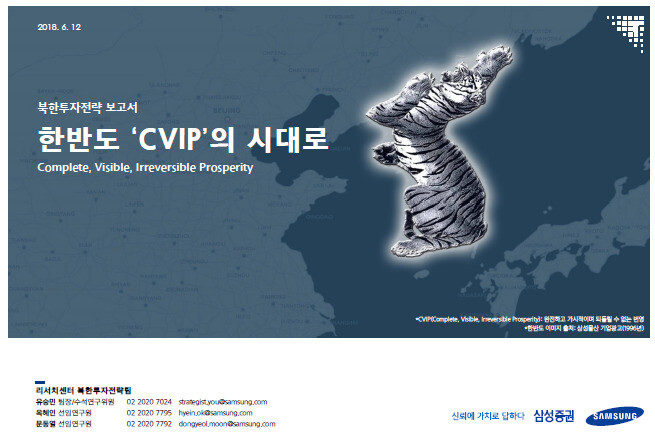hankyoreh
Links to other country sites 다른 나라 사이트 링크
North Korea’s reconstruction should be viewed as integration, not reunification

The standards for calculating the costs of North Korea’s economic reconstruction should be discussed in terms of “integration” rather than “reunification,” analysts are arguing.
Analysts also predicted the city of Wonsan is likely to become a landmark for North Korean economic openness.
A June 13 report by the Samsung Securities North Korean investment strategy team titled “Toward the CVIP Era on the Korean Peninsula” outlined possible scenarios for inter-Korean economic cooperation, predicting the recent North Korea-US summit in Singapore would become a “historic inflection point” with “an economy arriving in place of nuclear weapons and missiles.”

The “CVIP” in the title is an acronym for “complete, visible, irreversible prosperity.”
As a standard for calculating the costs of rebuilding the North Korean economy, Samsung Securities first introduced the concept of the “integration costs” needed to maintain peace and prosperity. Noting that the past “reunification cost” concept presumed a German-style absorption scenario, the report argued the situation should be approached through a “gradual economic integration” framework with international acknowledgement of the North Korean regime.
Applying the “integration cost” calculation standard reduces costs significantly from South Korea’s standpoint. It would not require the economic promotion and social security expenditures included in German-style reunification costs; instead, costs would be channeled chiefly into rebuilding North Korean infrastructure.
“South Korea may enjoy benefits including reduced defense costs, an end to ideology and system maintenance costs, economies of scale, and organic linkage of the South and North Korean regional economies, while North Korea can reduce the role of its defense industry and obtain effects in terms of adjusting its distorted industry structure,” Samsung Securities predicted.

Reparations from Japan could become seed money for North Korea’s reconstruction
The report also mentioned North Korea’s right to claim damages from Japan as a major resource for reconstruction. The prediction is that North Korea might be able to exercise its claims for “seed money” just as other countries victimized by Japanese invasions in the past – including South Korea, Vietnam, and the Philippines – used compensation from Japan to invest in various forms of infrastructure.
The amount of compensation was estimated at around US$20 billion. If North Korea does establish itself as a “normal state,” it would also be entitled to international support funds from the International Monetary Fund (IMF) and other sources, while a trust fund for North Korea’s development could be spearheaded by South Korea, the report suggested.
The report predicted that investment in construction, construction materials, and energy would be key in the initial stage of inter-Korean economic cooperation (“building an economic base and trust”), with a strong likelihood of early openness coming chiefly through North Korea’s special economic districts. In particular, it predicted that the Wonsan special economic zone – which is leader Kim Jong-un’s hometown and is linked to Mt. Keumgang – would become a landmark.
During the second stage (“reducing distrust and expanding openness”), South and North Korea may be able to jointly pursue resource development and invest in increasing value added from resources, it predicted. During this process, benefits were seen as likely to extend to the resource development, tourism, and distribution industries. The report also predicted financial industry support would be expanded to the private sector.
The third and final stage (“practical investment and full-scale cooperation”) could result in North Korea becoming a base of export industry production like the Eastern Europe of the past, the report said. Information technology (IT) and automobile assembly plants could be built in the North, and financial market openness would become possible.
On June 7, Samsung Securities became the first company to establish a dedicated North Korea research team to publish a report.
North Korean investment strategy team director Yu Seung-min said, “With differing assessments of the summit on June 12, the market appears likely to reflect that in a neutral way for the time being, but people’s hopes appear likely to be met as more meetings take place going ahead.”
“North Korea is expected to focus on pursuing economic development through its special districts and development districts to achieve development while maintaining regime security,” Yu added.
By Park Su-ji, staff reporter
Please direct comments or questions to [english@hani.co.kr]

Editorial・opinion
![[Column] Season 2 of special prosecutor probe may be coming to Korea soon [Column] Season 2 of special prosecutor probe may be coming to Korea soon](https://flexible.img.hani.co.kr/flexible/normal/500/300/imgdb/original/2024/0426/3317141030699447.jpg) [Column] Season 2 of special prosecutor probe may be coming to Korea soon
[Column] Season 2 of special prosecutor probe may be coming to Korea soon![[Column] Park Geun-hye déjà vu in Yoon Suk-yeol [Column] Park Geun-hye déjà vu in Yoon Suk-yeol](https://flexible.img.hani.co.kr/flexible/normal/500/300/imgdb/original/2024/0424/651713945113788.jpg) [Column] Park Geun-hye déjà vu in Yoon Suk-yeol
[Column] Park Geun-hye déjà vu in Yoon Suk-yeol- [Editorial] New weight of N. Korea’s nuclear threats makes dialogue all the more urgent
- [Guest essay] The real reason Korea’s new right wants to dub Rhee a founding father
- [Column] ‘Choson’: Is it time we start referring to N. Korea in its own terms?
- [Editorial] Japan’s rewriting of history with Korea has gone too far
- [Column] The president’s questionable capacity for dialogue
- [Column] Are chaebol firms just pizza pies for families to divvy up as they please?
- [Column] Has Korea, too, crossed the Rubicon on China?
- [Correspondent’s column] In Japan’s alliance with US, echoes of its past alliances with UK
Most viewed articles
- 1‘We must say no’: Seoul defense chief on Korean, USFK involvement in hypothetical Taiwan crisis
- 2After election rout, Yoon’s left with 3 choices for dealing with the opposition
- 3AI is catching up with humans at a ‘shocking’ rate
- 4[Editorial] Korea’s surprise Q1 growth requires objective assessment, not blind fanfare
- 5Noting shared ‘values,’ Korea hints at passport-free travel with Japan
- 6Why Kim Jong-un is scrapping the term ‘Day of the Sun’ and toning down fanfare for predecessors
- 7Two factors that’ll decide if Korea’s economy keeps on its upward trend
- 8Amnesty notes ‘erosion’ of freedom of expression in Korea in annual human rights report
- 9The dream K-drama boyfriend stealing hearts and screens in Japan
- 10Yoon says collective action by doctors ‘shakes foundations of liberty and rule of law’